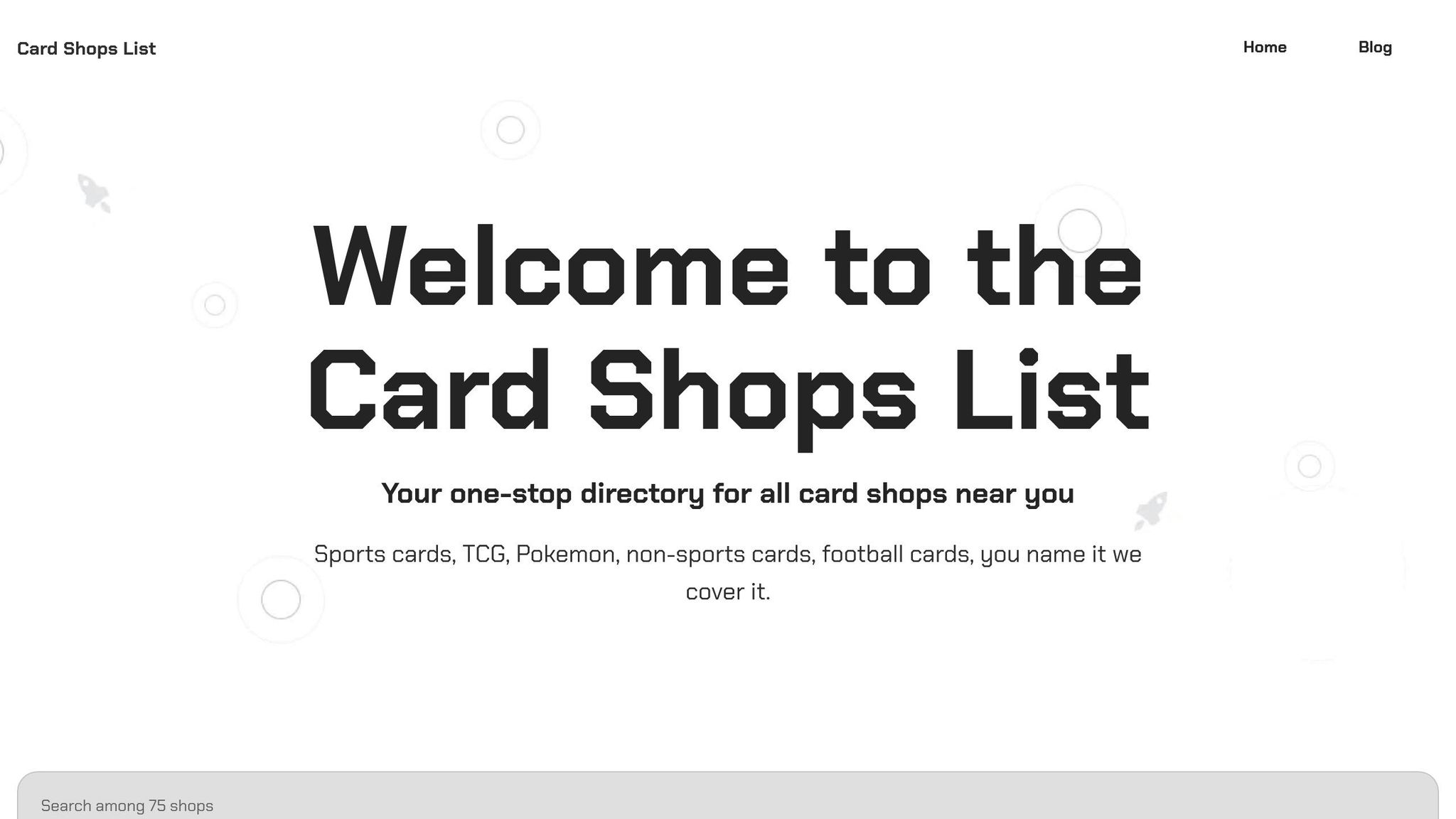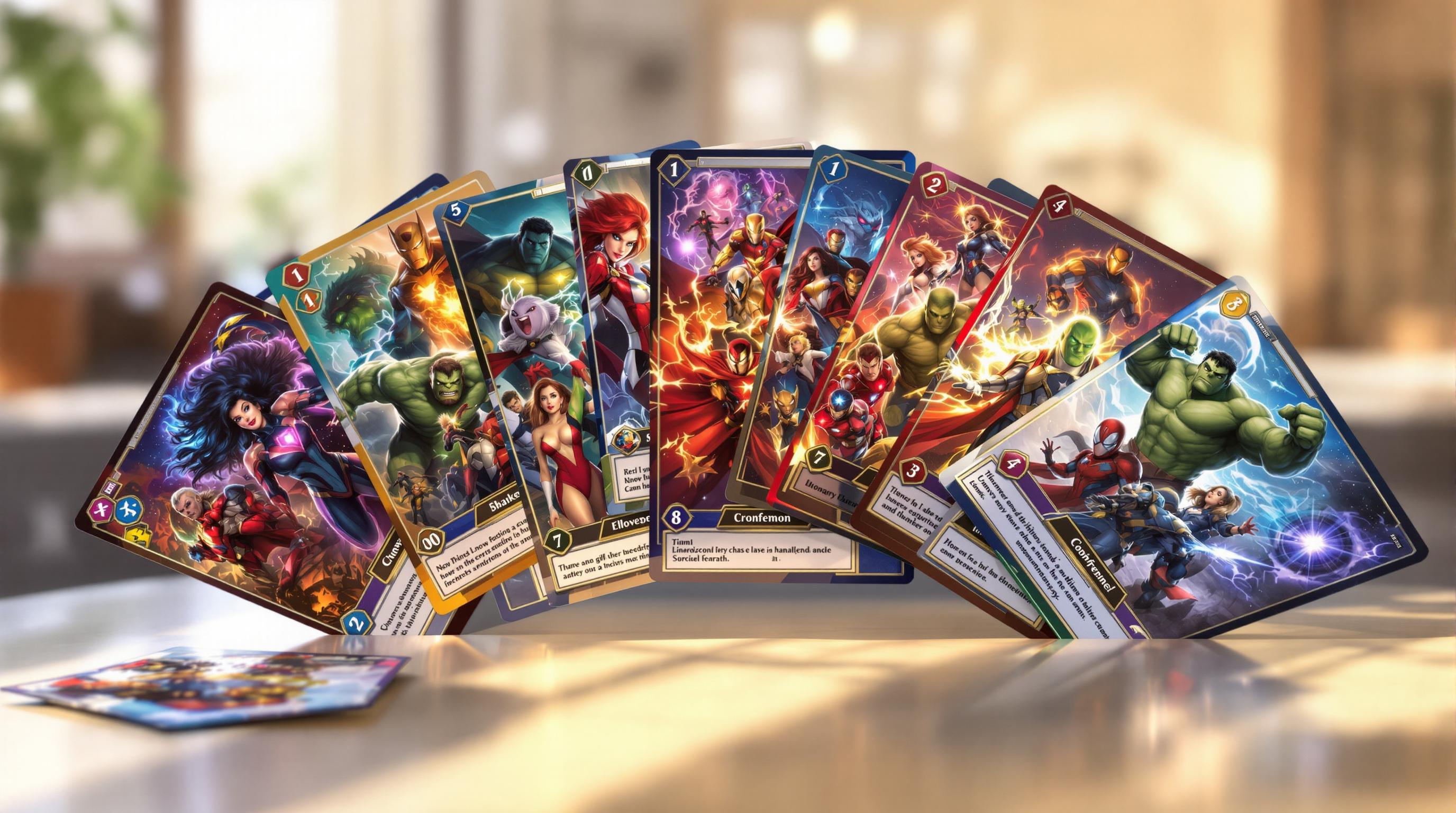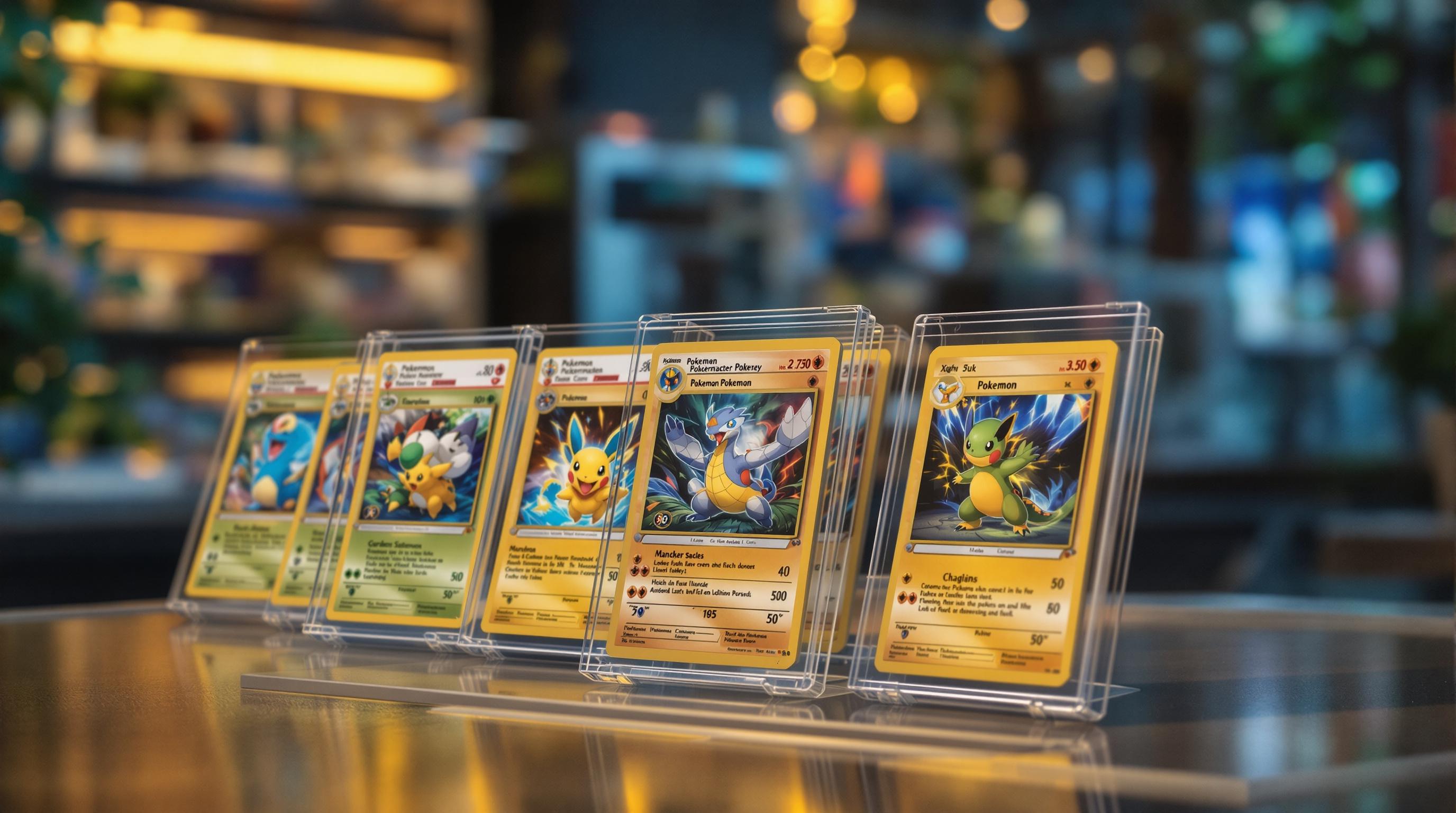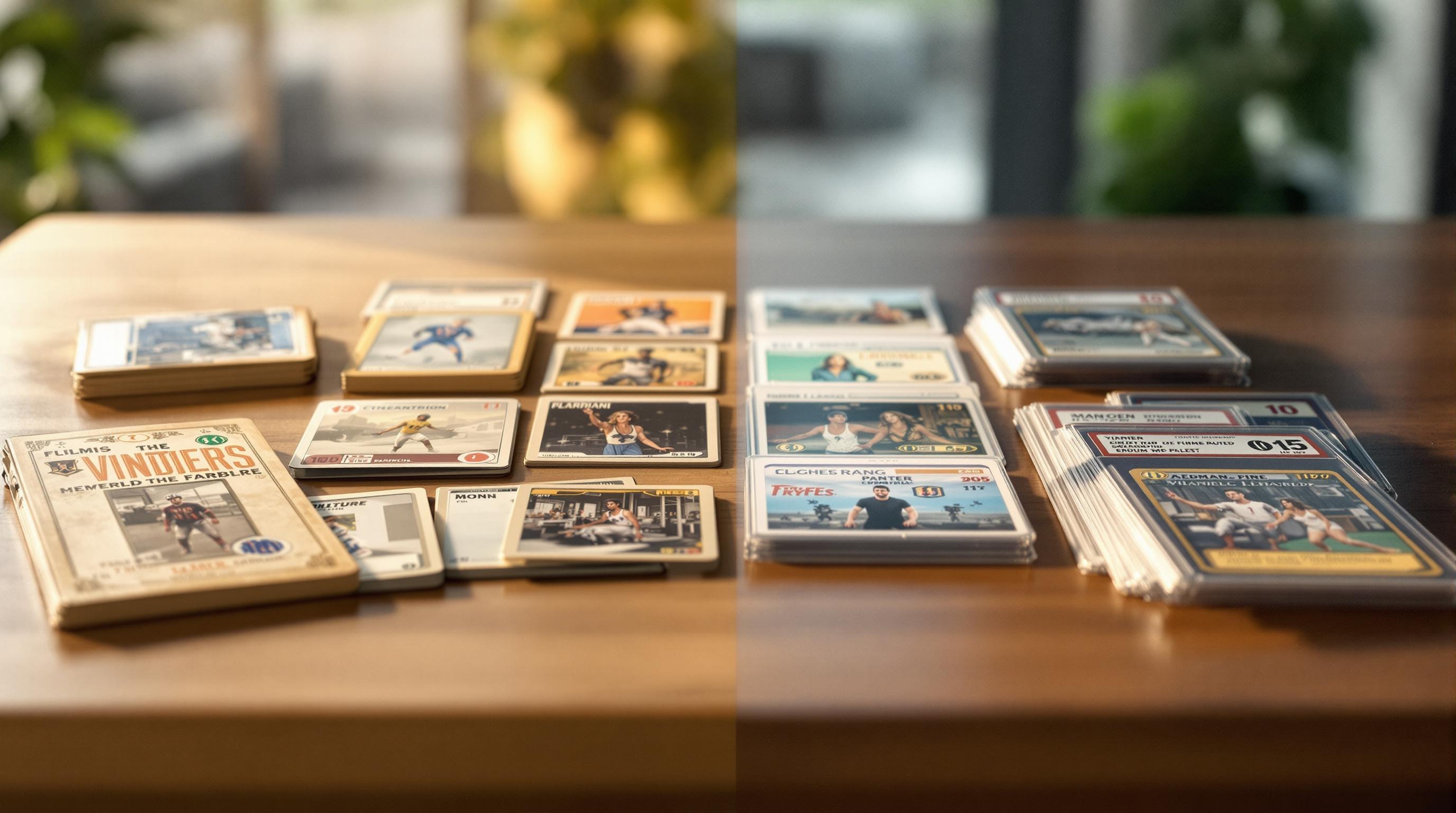Promo cards are rare trading cards distributed through events, promotions, or exclusive products. They’re collectible, often tournament-legal, and valued for their scarcity and unique designs. To successfully collect promo cards, focus on these key steps:
- Where to Find Them: Look on online marketplaces (e.g., eBay, COMC), specialized dealer websites, auction houses, card shows, and social media groups. Use tools like Card Shops List to locate local stores.
- How to Identify Them: Spot unique symbols, markings like "PROMO", distribution context (e.g., events), and unusual set numbers.
- Authenticity Checks: Verify print quality, paper texture, foil patterns, and official markings. For expensive cards, consider grading services like PSA or BGS.
- Storage Tips: Use penny sleeves, top loaders, and team bags. Keep cards in stable conditions, away from sunlight, heat, and moisture.
- Organizing Your Collection: Track cards in a spreadsheet or app, and connect with collector communities for trades and insights.
Do You Have THESE Pokemon Promo Cards? Check Your Binders! SMART Pokemon Investing!
Where to Find Promo Cards
Tracking down promotional cards can be both an exciting and challenging endeavor. Whether you're browsing online or visiting physical locations, each avenue offers its own perks for collectors. Let’s dive into some of the most effective ways to uncover these exclusive treasures.
Common Sources for Promo Cards
Online marketplaces are a go-to option for many collectors. Platforms like eBay, COMC, MySlabs, and Sportlots provide a wide array of options, from common to rare promotional cards. These sites let you compare prices, check seller ratings, and often include detailed photos to confirm authenticity before you commit to a purchase.
Another reliable option is specialized dealer websites. Retailers like Blowout Cards, Dave and Adam's Card World, and Burbank Sports Cards focus on trading cards and frequently carry promotional items. Thanks to their direct connections with manufacturers, these sites often have access to exclusive releases and event-specific promos.
For rare or high-value promo cards, auction houses like Goldin, PWCC, Heritage, and Pristine are worth exploring. These venues specialize in authenticated items with clear provenance, making them ideal for collectors seeking vintage promos or unique items like contest prizes or tournament exclusives.
Card shows are another excellent resource for finding promotional cards. These events bring together numerous dealers under one roof, offering a chance to browse diverse inventories. The in-person format lets you inspect cards firsthand and negotiate prices directly with sellers, making it a dynamic and rewarding experience.
Lastly, online forums and social media groups have become powerful tools for collectors. Platforms like Reddit, Facebook, Instagram, and Twitter host vibrant communities where members share tips, trade cards, and alert each other about upcoming releases or rare finds. Many promo cards are discovered through these networks before they even hit mainstream markets.
Using Directories Like Card Shops List

For those who prefer shopping locally, Card Shops List is a handy tool. This directory helps you locate nearby card shops by simply entering your city, state, or ZIP code. It’s an easy way to uncover stores you may not have known about.
The platform also offers filters to refine your search. For example, you can look for shops specializing in specific trading card games like Pokémon, Magic: The Gathering, or Yu-Gi-Oh! This increases your chances of finding promotional items tied to those franchises. Some shops even focus on non-sports cards, entertainment collectibles, or sports memorabilia, giving you more targeted options.
Local card shops have their own unique advantages. Store owners often have insider knowledge about upcoming promo releases and connections with other collectors who might sell rare items. They can also notify you when specific promo cards arrive. Plus, many shops host events where promotional cards are distributed, giving you a chance to snag them right at the source.
How to Spot Promo Cards
Recognizing promotional cards often comes down to identifying specific visual markers. For instance, unique symbols are a reliable giveaway. In Magic: The Gathering, older promo cards often feature a "shooting star" set symbol, while newer promo pack cards display a "planeswalker" symbol in the art box. Pokémon promo cards are marked with a distinctive black star accompanied by the word "PROMO".
"The 'shooting star' set symbol is common. Current promo pack cards will have the 'planeswalker' symbol in the art box. Date stamps on the card are a good indicator. Sometimes they will be marked as promo on the bottom of the card too." – Dennis John O'Malley II
Explicit markings are another clue. Many promotional cards have "promo" printed on the bottom, and some include date stamps showing when they were distributed.
The context of distribution also helps identify promo cards. Items handed out during special events, tournaments, movie premieres, or exclusive retail promotions (like McDonald’s Happy Meals) are often promotional in nature.
Lastly, set numbering anomalies can indicate a card’s promotional status. For example, secret rare cards sometimes have set numbers exceeding the total listed for the set (like 115/114), signaling their special nature. Familiarity with series like Pokémon's Black Star Promos or POP Series can make it easier to spot these gems when browsing collections or marketplaces.
"They are clearly marked as promo cards by the black star on them that says 'promo'." – Titan Cards Ltd
Checking Authenticity and Value of Promo Cards
Once you've found some promo cards, the next step is to confirm they're genuine and figure out their value. Counterfeit cards can be surprisingly convincing, so understanding how to authenticate them is a must for any collector.
How to Verify Authenticity
Start with the print quality. Genuine promo cards usually have sharp, clear printing with consistent color saturation. Under bright light, look for blurry text, misaligned graphics, or color bleeding - these are signs of a fake.
Pay attention to the paper stock and texture. Authentic cards are printed on specific cardstock with a distinct feel and weight. Check the edges for smooth, even borders. If the card feels overly glossy or the texture seems off, it might not be real.
Examine the foil patterns and holographic elements. Many promo cards feature unique foiling, rainbow patterns, or holographic stamps that are tough to replicate. Compare these details with verified authentic cards using official images or reliable price guides.
Don't overlook official markings. Check for accurate symbols, set numbers, and copyright details. For instance, Magic: The Gathering promos should display the correct set symbol, while Pokémon cards must have the appropriate copyright year and legal text format for their release period.
For high-value cards, consider professional grading services like PSA, BGS, or CGC. These services authenticate cards as part of their grading process. While there’s a fee and some wait time, they offer peace of mind when dealing with rare or expensive cards.
What Determines a Card's Value?
Once you've confirmed a card's authenticity, several factors come into play when assessing its value.
- Rarity and distribution method: Cards distributed in limited quantities, such as those handed out at smaller events, are often more valuable than widely released ones.
- Condition: Promo cards are frequently handled at events, so even minor damage can lower their value. Cards in mint or near-mint condition fetch much higher prices than those with visible wear.
- Age and historical significance: Older promo cards or those tied to major events and milestones often gain value over time, driven by nostalgia and their historical importance.
- Market demand: The value of a card can fluctuate based on trends and the popularity of the game. Staying updated on market trends through price guides and auction data is essential for accurate valuation.
Tools for Pricing and Research
Once you've evaluated authenticity and value factors, use reliable price guides, auction results, and official checklists to determine a card's worth. Platforms like eBay can provide insights into recent sales, but remember to consider the card's condition and any professional grading.
Collector communities and forums are also great resources. Platforms like Reddit and Discord often have active groups sharing price trends, authentication tips, and market insights. Keeping records of your research - such as screenshots of sales, condition notes, and comparisons - can help you make informed decisions and serve as documentation for future reference.
sbb-itb-0db97a5
How to Store and Preserve Promo Cards
Taking care of your promo cards is crucial for keeping their value intact. These cards often have limited releases and unique distribution, which makes them special - but also means their condition can greatly affect their worth. Let’s dive into how to handle and store them properly.
Proper Card Handling
Start with clean hands and a tidy workspace. Wash and dry your hands thoroughly, and make sure you’re working on a flat, clean surface far from food or drinks. When handling the cards, hold them by the edges using a pinch grip, and always support the entire card to avoid bending or creasing. If you need to inspect the card closely, place it on a flat surface instead of holding it in the air. This minimizes the risk of accidental damage. Also, keep your cards away from direct sunlight, as it can cause fading. Once you’re done, return the cards to their protective storage to keep them safe.
Storage Options
After careful handling, the next step is choosing the right storage method to keep your cards in top condition.
- Penny Sleeves: Use acid-free, PVC-free sleeves to protect your cards. Insert the card slowly to avoid bending the corners.
- Top Loaders: For extra rigidity, place sleeved cards into top loaders. This is especially important for high-value cards. Always sleeve the card first to prevent scratches.
- Team Bags: Protect sleeved and top-loaded cards further by placing them in team bags. These shield against dust, moisture, and scratches.
- Sealed Promo Packs: For unopened promo packs, store them in hard plastic boxes or between rigid holders inside a team bag to prevent compression damage.
Remember to store your cards in a space with stable temperature and humidity. Extreme conditions can lead to warping or other damage.
Storage Methods Comparison
| Method | Protection Level | Cost | Accessibility |
|---|---|---|---|
| Card Sleeves | Moderate | Low ($) | High |
| Top Loaders | High | Moderate ($) | Moderate |
| Magnetic Holders | Very High | High ($) | Low |
For most collectors, a triple-layer approach works best: start with a penny sleeve, add a top loader, and finish with a team bag. This combination offers excellent protection at an affordable cost - usually under $1.00 per card. If you have particularly valuable cards, magnetic holders are a great option. They provide top-tier protection and make your cards easy to display, giving them the attention they deserve.
Managing and Growing Your Promo Card Collection
Once your storage setup is sorted, the next step is keeping track of what you have and planning how to expand your collection. A little organization and forethought can save you from buying duplicates and help you zero in on those rare gems you’ve been searching for.
Tracking Your Collection
Keeping a detailed record of your cards is essential. It not only helps you avoid duplicates but also highlights the gaps you need to fill. A simple spreadsheet can do the trick - list each card's name, set, condition, purchase date, price, and estimated value. Many collectors swear by Google Sheets because it’s free, accessible from anywhere, and easy to share.
For a more advanced option, consider apps designed for collectors. These can scan your cards, pull in real-time market prices, and even notify you of value changes. Adding photos of your cards to your tracking system is also a smart move. It gives you a quick visual reference, especially for your most valuable pieces, and can be handy when browsing shops or online listings.
Once your collection is organized, the next step is tapping into the collector community to enhance your strategy.
Connecting with Other Collectors
The promo card world is as much about community as it is about the cards themselves. Engaging with other collectors not only broadens your knowledge but also opens up trading opportunities. Reddit is home to active groups where enthusiasts discuss upcoming releases and share tips. Local card shops often host trading nights or meetups, giving you the chance for face-to-face trades and access to unique cards. Facebook groups are another treasure trove for insider advice on tracking down specific promos or staying updated on limited-time releases. Building relationships in these spaces can lead to valuable trades and insights.
Planning Future Purchases
A little planning goes a long way in collecting. Instead of buying on impulse, create a prioritized wish list with target prices. This keeps your collection focused and your spending under control. It’s also helpful to research release schedules for the types of cards you’re after - promo sets often align with seasonal sales or tournament events, offering great opportunities to snag something special.
If you’re traveling, use tools like Card Shops List to scout out stores in your destination. Comparing availability and prices in different regions can lead to unexpected finds. To keep everything manageable, set a monthly collecting budget. Divide it between must-haves, potential investments, and a little extra for surprise opportunities. This ensures you can grow your collection steadily without overextending yourself.
Key Points for Promo Card Collectors
Building a successful promo card collection means focusing on four key areas: sourcing, authentication, preservation, and organization.
Finding quality promo cards starts with knowing where to search. Online marketplaces are convenient, but local card shops offer something extra: the chance to inspect cards in person. These shops often carry unique regional releases and may host exclusive promotional events you won’t find online. Using local directories can help you discover these hidden gems.
Once you’ve sourced your cards, authenticating them is crucial. This step protects your investment and ensures your collection’s integrity. For high-value promo cards, professional grading services like PSA, BGS, and CGC can verify authenticity and assess condition. For example, a PSA 10 "Gem Mint" card can fetch significantly higher prices than a PSA 9 "Mint" card. That said, grading fees can add up, so weigh the costs against potential value increases before submitting your cards.
Preserving your cards properly is essential from the moment you acquire them. Always handle cards with clean hands, touching only the edges to avoid transferring oils. For extra care, white cotton gloves can be a smart choice. Start with acid-free sleeves to protect the surface, then use rigid top loaders or hard cases for added security. Store your collection in a stable environment - away from direct sunlight - with consistent temperature and humidity levels.
Organizing and tracking your collection helps prevent duplicates and highlights any gaps. Use an inventory system, whether it’s a simple spreadsheet or a specialized collector app, to log details like card names, sets, conditions, purchase dates, and current values. When it comes to storage, choose D-ring binders over O-ring ones - they reduce the risk of card denting by 64.209 percent.
FAQs
How can I make sure the promo cards I buy online are authentic?
To make sure the promo cards you buy online are genuine, start by sticking to well-known sellers or platforms that offer strong buyer protections. Check for sellers with solid reviews and a proven track record in dealing with collectible cards.
Pay close attention to the card's details - things like the clarity of the image, the accuracy of the font, and the overall quality. Fake cards often stand out with blurry images, incorrect text, or strange textures. If you're still unsure, you can have the card professionally graded by trusted companies like PSA or Beckett. These services can verify the card's authenticity.
For higher-value cards, professional grading or using verification tools can provide added assurance. Taking these precautions will help you avoid fakes and keep your collection safe.
What’s the best way to store and protect promo cards to keep them in top condition?
To keep your promo cards in great shape and retain their value, use archival-quality protectors like top-loaders, semi-rigid cases, or UV-resistant sleeves. These provide a strong defense against dust, moisture, and scratches.
Avoid exposing your cards to direct sunlight or UV light, as this can cause fading over time. Instead, store them in a cool, temperature-controlled space, preferably in opaque containers to block out light. For extra care, you might organize your cards in binders with sturdy, rigid pages to prevent any bending or creasing.
By following these tips, you can preserve your promo cards and keep them looking as good as new for years.
What’s the best way to organize and track my promo card collection to avoid duplicates and fill gaps?
To keep your promo card collection in order and avoid ending up with duplicates, try using digital tools like spreadsheets or collector-focused apps. These tools let you log your cards, sort them by categories such as rarity, set, or release date, and quickly spot any missing pieces in your collection. Regular updates to your inventory can save you from buying cards you already own.
For a more hands-on approach, consider grouping your cards by themes or sets and storing them in labeled binders or storage boxes. This method not only keeps everything tidy but also makes it a breeze to find specific cards when you need them. With these simple steps, managing your collection becomes a lot more straightforward and enjoyable.


